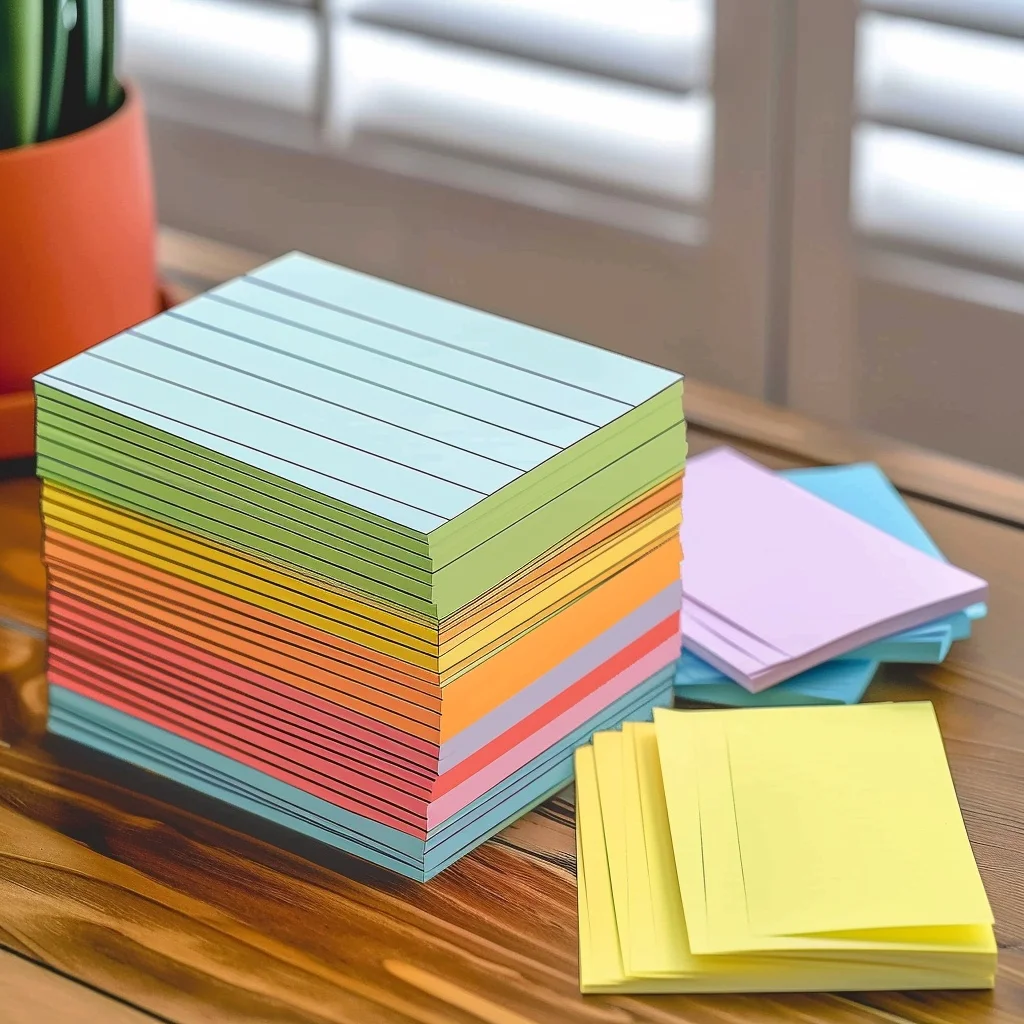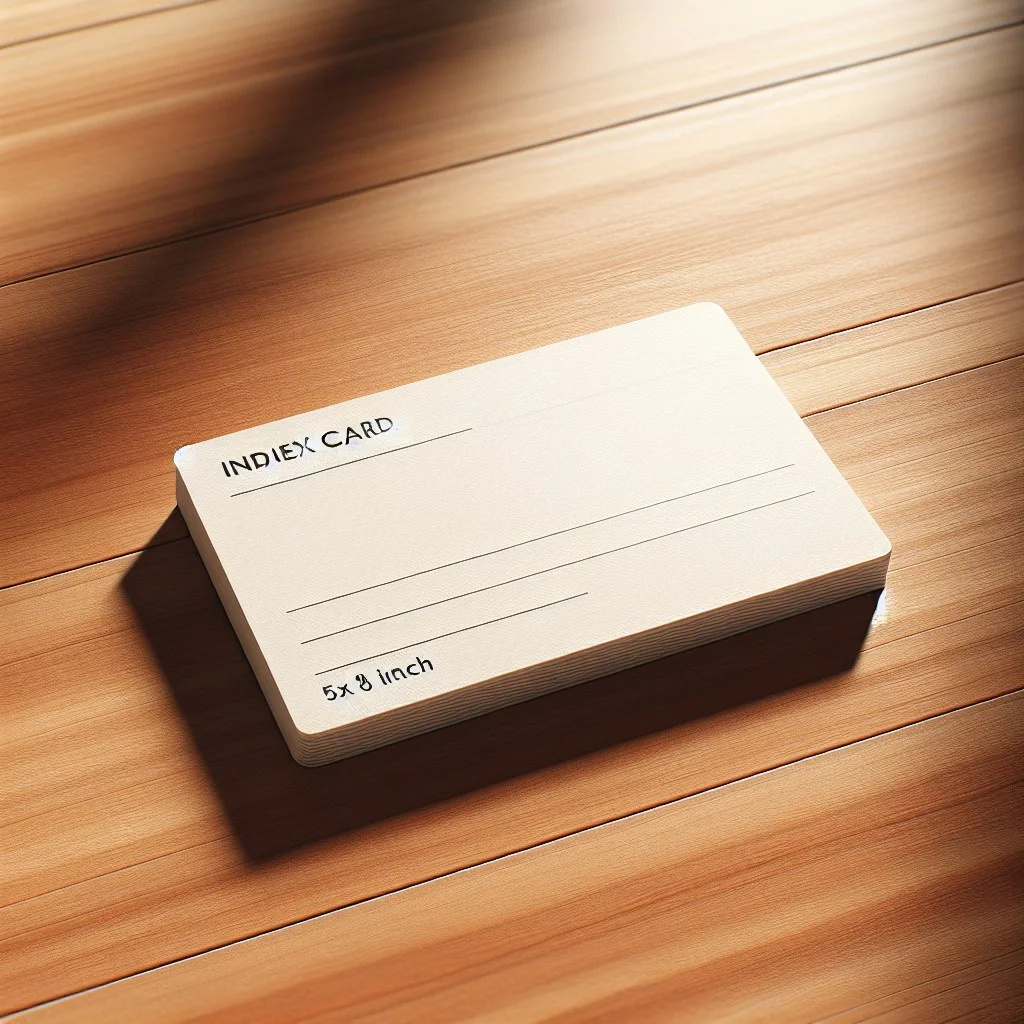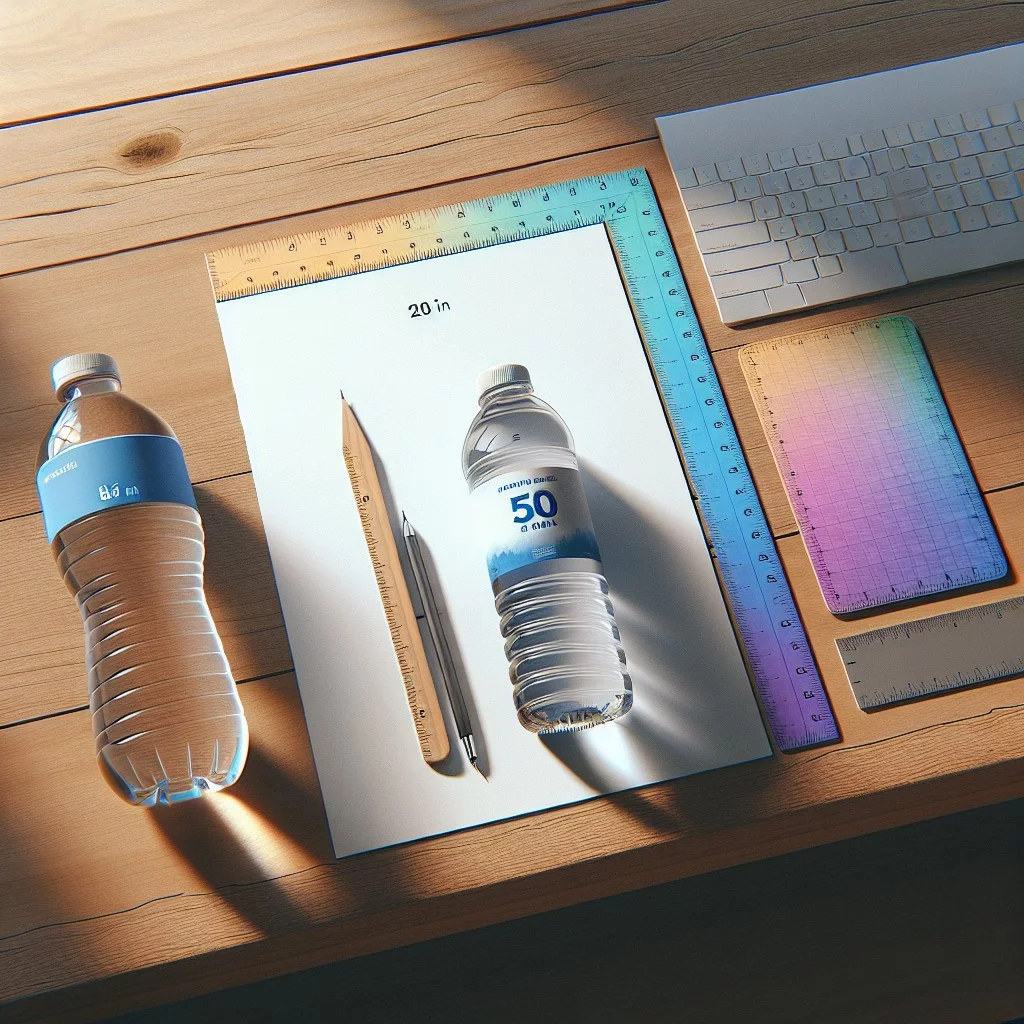Last updated on
Dive into the captivating world of stationery as we delineate the dimensions of an index card in this detailed comparison guide.

Key takeaways:
- 3×5 inch: Compact for short notes, flashcards, and organizational tags.
- 4×6 inch: Offers more space for detailed notes, recipes, or data compilation.
- 5×8 inch: Ample space for comprehensive notes, project outlines, or sketches.
- Thickness ranges from 0.007 to 0.011 inches (110 to 130 lb cardstock).
- Consider purpose, portability, storage, legibility, and durability when choosing size.
What's Inside
What Are the Different Sizes of Index Cards?

Index cards come primarily in three sizes, each tailored for a variety of tasks and storage options:
- The most common size is the 3×5 inch card. Compact and readily available, these are perfect for short notes, flashcards, and organizational tags.
- Next up is the 4×6 inch card, offering more space for those needing extra room for detailed notes, recipes, or more extensive data compilation.
- Lastly, the 5×8 inch cards cater to users requiring ample space for comprehensive notes, project outlines, or even small sketches, without the bulkiness of a notebook.
It’s important to note that while these sizes are standard in the United States, availability might vary globally, and other countries could have additional standard sizes. Keep the intended use in mind when selecting the size that best fits your need.
X 5 Index Cards

Regarded as the classic size, the 3 x 5 card offers an ideal compromise between space and portability. These pocket-sized powerhouses are favorites for students making flashcards, speakers crafting speech notes, and organizers jotting down to-do lists.
Their compact dimensions fit perfectly in hand, making them easy to handle and review on the go. In fact, their portability allows for seamless integration into study sessions, as you can conveniently carry a stack without the bulk.
For home organization, these cards slide effortlessly into recipe boxes or are clipped to fridges with magnets for easy viewing. Their size aligns with traditional card filing systems, simplifying the categorization and retrieval in office settings.
In creative circles, the 3 x 5 canvas suits brainstormers, letting ideas flow freely without the intimidation of a large blank page. Despite their small stature, these cards provide ample room for a clear, legible script, supporting concise content that gets to the point.
X 6 Index Cards
Shifting to the slightly larger 4 x 6 inches dimension, these cards offer more space, ideal for those needing extra room for comprehensive notes or sketches. They are particularly handy for:
- Study Aid: With more area to play with, students can outline topics in greater detail, diagram processes, or create flashcards rich with information.
- Recipes: Home cooks and chefs alike appreciate the additional writing real estate to scribble down more elaborate recipes or baking instructions.
- Presentations: Professionals who rely on cue cards for speeches can benefit. The larger format accommodates bigger fonts or more bullet points, making those quick glances during a talk more effective.
- Organizational Tags: For organizing larger bins or shelves, the 4 x 6 size allows for more visible labels and can be read from a distance, which streamlines finding items in storage areas.
In this dimension, the extra inch in both width and height compared to the standard 3 x 5 opens up a new array of possibilities without being too large to handle with ease.
What Size Are Large Index Cards?
When it comes to larger formats, these cards typically measure 5 x 8 inches. This extra space provides ample room for more extensive notes, complex diagrams, or comprehensive lists. Ideal for detailed study aids, project planning, and even recipes, the expansive surface serves those who need more than just a few lines for their endeavors.
The oversized option ensures that no idea is too big to be captured on an index card, facilitating better organization and visualization of larger chunks of information. These cards often become the go-to for visual thinkers, educators, and professionals who require a broader canvas for their thoughts and strategies.
What Is the Largest Index Card?
When it comes to sheer size, the largest standard index card you’ll typically find measures a substantial 5 x 8 inches. This extra space is ideal for more extensive notes, complex diagrams, or when more content is required without flipping through multiple cards. They serve as a versatile tool for educators and students alike who may need additional area for classroom activities or intricate study guides.
Beyond this standard size, some manufacturers might produce even larger custom sizes, but these are not as common nor standardized. The 5 x 8 inch cards are a happy medium between being large enough to hold plentiful information and small enough to retain portability and the classic index card feel.
What Is the Thickness of an Index Card?
Understanding the thickness of an index card is crucial when considering its durability and potential uses. Typically, index card stock ranges from about 0.007 inch (0.18 mm) to 0.011 inch (0.28 mm), corresponding to what’s known as “110-lb” to “130-lb” cardstock. This terminology refers to the weight of 500 sheets of the paper measuring 20 x 26 inches.
A standard index card’s heft not only affects how it feels but also contributes to its ability to stand up to handling, writing, and even art projects. For everyday note-taking and organizing, a less thick card may suffice. However, for crafts or professional presentations, a sturdier, thicker card is more desirable as it resists bends and tears and usually bears ink better without bleeding through.
When purchasing index cards, it’s good to note that the thickness is not always listed directly. Paperweight might be the indicator provided, and knowing the conversion to thickness can help in making an informed choice. Most office supply stores offer index cards in various weights, allowing you to select the right thickness for your specific need.
Tips for Choosing the Right Index Card Size
Selecting the appropriate index card size revolves around purpose and personal preference. Consider these key points to guide your decision:
- Intended Use: For quick, brief notes or flashcards, stick to the classic 3 x 5 cards. If you need more space for detailed information or sketches, opt for 4 x 6 or even larger sizes.
- Portability: If you’re always on the go, smaller index cards are your allies. They fit easily into pockets and small bags, making them convenient for study sessions anywhere.
- Storage: Have a designated storage spot for your cards? Make sure the size you choose aligns with your organizational system, whether it’s a card box or a binder.
- Legibility: If you have larger handwriting or prefer to include visuals like graphs or images, larger cards give you the canvas you need without the clutter.
- Durability: Larger cards can be sturdier, making them a better choice if you’ll be handling them frequently or using them in environments where wear and tear are likely.
Remember, the right size should enhance your ability to record, review, and retain information efficiently.
Creative Uses for Index Cards
Beyond merely jotting down notes or creating flashcards, index cards can spark creativity and organization in countless ways. Turn these unassuming rectangles into a deck of DIY playing cards with personalized designs for family game nights.
In the kitchen, they transform into recipe cards that stand the test of time—far sturdier than paper slips.
For those seeking order in a chaotic workspace, use them for a Kanban board—a visual workflow management tool—making tasks visually manageable and gratifying to move from ‘to-do’ to ‘done.’
Literature enthusiasts can create pocket-sized book summaries, keeping track of key themes or favorite quotes.
In the garden, these cards are perfect for homemade plant labels, enduring the elements when laminated, and providing a quick reference for plant care.
Finally, unleash your inner artist by making miniature sketches or watercolor paintings, a charming endeavor that can result in a collection of petite masterpieces to gift or display.
FAQ
Is an index card 4×6?
Yes, an index card can indeed measure 4 inches by 6 inches.
What is the size of an index card?
The standard sizes of an index card include 3×5 inches, 4×6 inches, 5×8 inches, and ISO-size A7.
Are index cards 3×5?
Yes, the standard size for index cards in the United States is indeed 3×5 inches, though there is a variety of sizes available as well.
Is 3×5 index card 1 8?
Yes, a 3×5 index card is often considered to be 1/8 in size.
Can index cards come in different dimensions other than the standard sizes?
Yes, index cards can indeed come in different dimensions other than the standard sizes.
How are the dimensions of an index card determined and why?
The dimensions of an index card, typically 3×5, 4×6, or 5×8 inches, are determined by the standardized guidelines for stationery products, providing optimal space for note-taking and easy categorization in standard storage boxes or files.
Do different countries have varying standard index card sizes?
Yes, different countries have varying standard index card sizes; for example, in the U.S., the most common size is 3 x 5 inches, while in the UK, an A7 (74 x 105 mm) size is typical.




